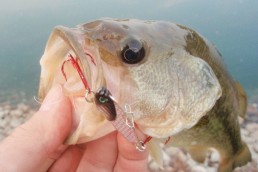Blade Baits Take Bass in the Spring
SHARE THIS POST
On a wet spring day, when I felt that I needed to take a break from my writing and decided a little bass fishing would be just the ticket, I looked through my rod rack and grabbed a spinning rod that had a Texas-rigged tube tied on. The air temperature hovered around 50 degrees, the sky was overcast, rain pelted the metal awning over my porch and the wind was out of the north. Not the best conditions for tube fishing, but I figured, what the heck? The little green tube was a dynamite lure and I was only fishing for a short time, so I left it on—but not for long.
The recent rains had riled the water, which already was cold and the tube garnered me exactly one strike that I missed. After pondering this situation for about six seconds, I decided to switch to a lure that made more sense under these conditions. I tied on a small blade bait and began catching largemouths. These were not sluggish, as they followed the lure into the shallows and smashed it as expected.
Why did it work? Largemouths, as with many other predatory species, are primarily sight-feeders, but when their vision is impaired by murky water they rely heavily on their other senses. In this case, the fish detected the lure by picking up its vibrations with the sensitive lateral lines. This is the salient feature of a blade bait—it’s long, has a lean profile and its weight-forward construction causes a tremendous amount of vibration. My tube lure might have looked good to the fish, but it did not have enough action to provoke an aggressive strike.
The lure was a Showdown blade by Worden’s Lures. I have had similar success with Bass Pro Shop’s great XPS blades that have holographic finishes that emit light flashes in conjunction with the vibration and are offered with red hooks in various models. I’ve also had good luck with VIB“E” blades by Rod Bender’s Tackle. These are just three, and most are similar in size, shape and action, and are effective under the right conditions, especially if dressed up with Red Daiichi treble hooks.
Blade baits are not infallible. More than one angler has cursed his luck when a fish has turned against the lure and gotten off the hook. The quality blades come equipped with a strong split ring that does not afford the fish the leverage to throw the hook. Whatever you choose, make sure it has a black snap for attaching the line otherwise the line-tie holes might cut your line.
Fishing these lures for largemouths or smallmouths is pretty much a no-brainer. Cast it out and reel it in. You can vary your retrieve and tweak the action by speeding up and slowing down, and by pumping your rod tip and allowing the lure to flutter momentarily. While I have not yet used blade baits on walleyes, I have to believe that this “dying flutter” action would be dynamite on both ‘eyes and northern pike.
Are you enjoying this post?
You can be among the first to get the latest info on where to go, what to use and how to use it!
Over the past year or so I have been using blade baits on the saugeyes in Indian Lake Reservoir and have been pleased with the results. Anglers there jig the lures under or near any bridge or at the mouths of the many channels. In addition to jigging, I often cast them to offer fish something unseen.
My neighbor came home with three dandy saugeyes he had caught at dusk. The first was a nice-sized “eater,” the next two that I weighed and photographed were 4 1/2- and 6 1/2-pound beasts. His lure, of course, was a blade bait. Remarkably, he caught them from shore on a light-action rod spooled with 4-pound-test Spider Wire—that’s some mighty exciting fishing.
The shallow lake he fished was whipped to a “froth” with pleasure boaters, jet-skiers and bass boats. As mentioned earlier, when the conditions get tough the predators rely on their other senses. Just as their walleyed cousins, saugeyes are followers, and when they invade the shallows in the spring they will attack a lure that not only looks good, but also “sounds” good. They too have amazing eyesight, and in dark waters anything that looks like escaping food is going to get killed.
Many blades can still be purchased for less than $5, and have proven to possess multi-species attraction and are ideal reaction baits. For a different spin on your spring and summer, give them a try.
MWO
SHARE THIS POST
Did you enjoy this post?
You can be among the first to get the latest info on where to go, what to use and how to use it!
John Bennett
John Bennett is a retired history teacher, historical re-enactor, father and grandfather. As a four-season outdoorsman, his passion is waterfowl hunting and fishing for smallmouth bass. He lives in Ohio and spends quite a bit of time in his primitive log cabin, which he built.



